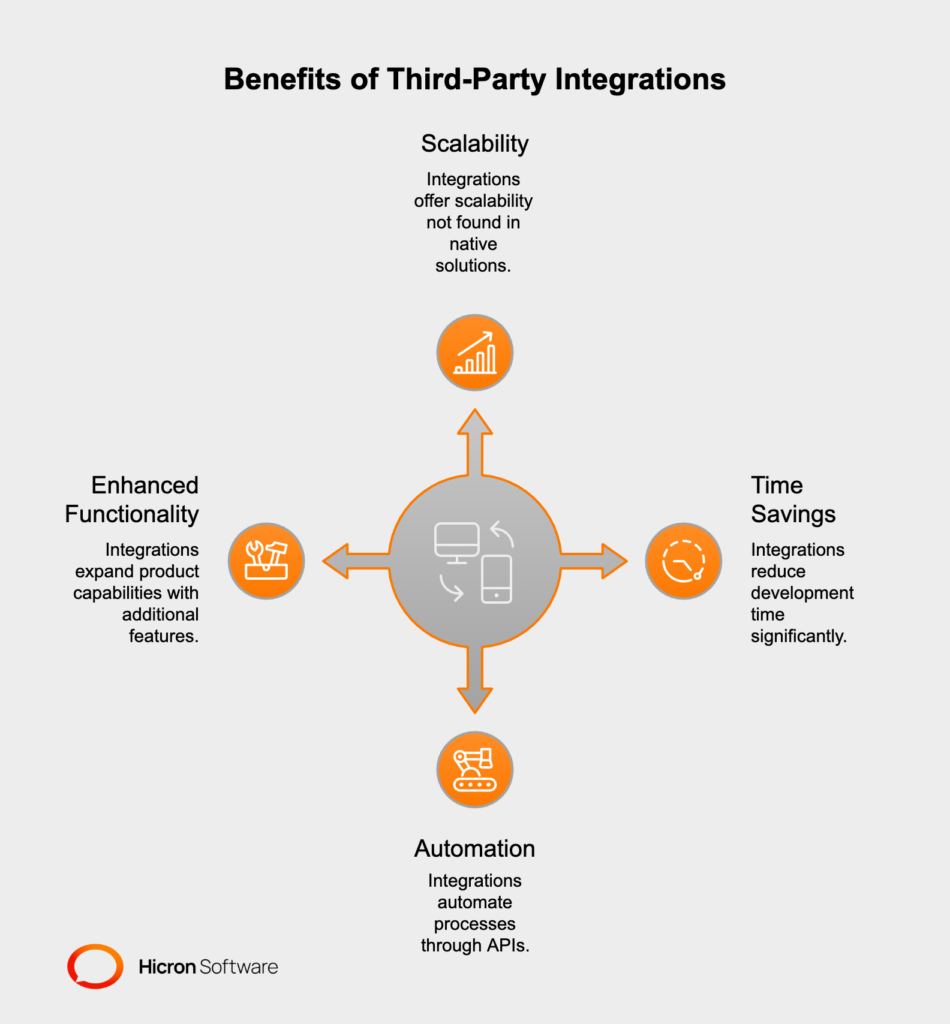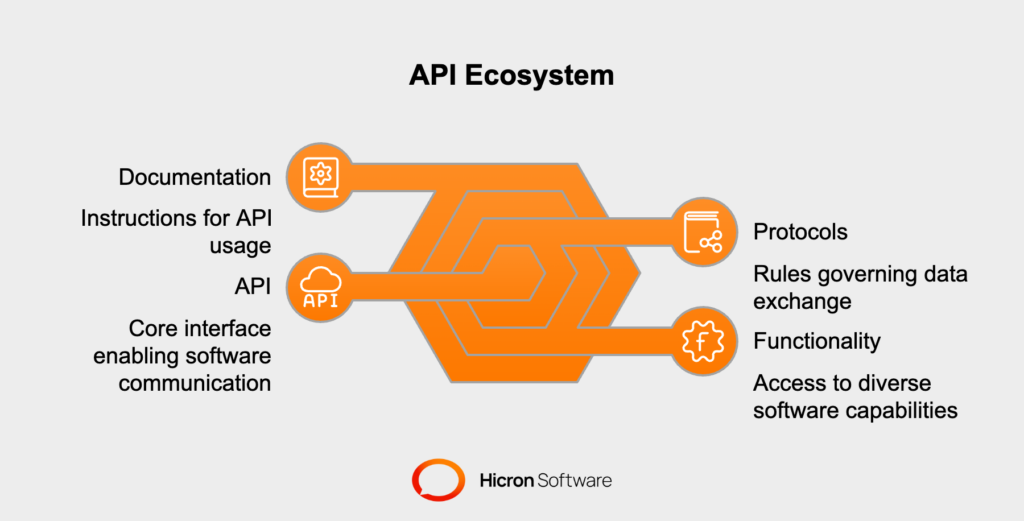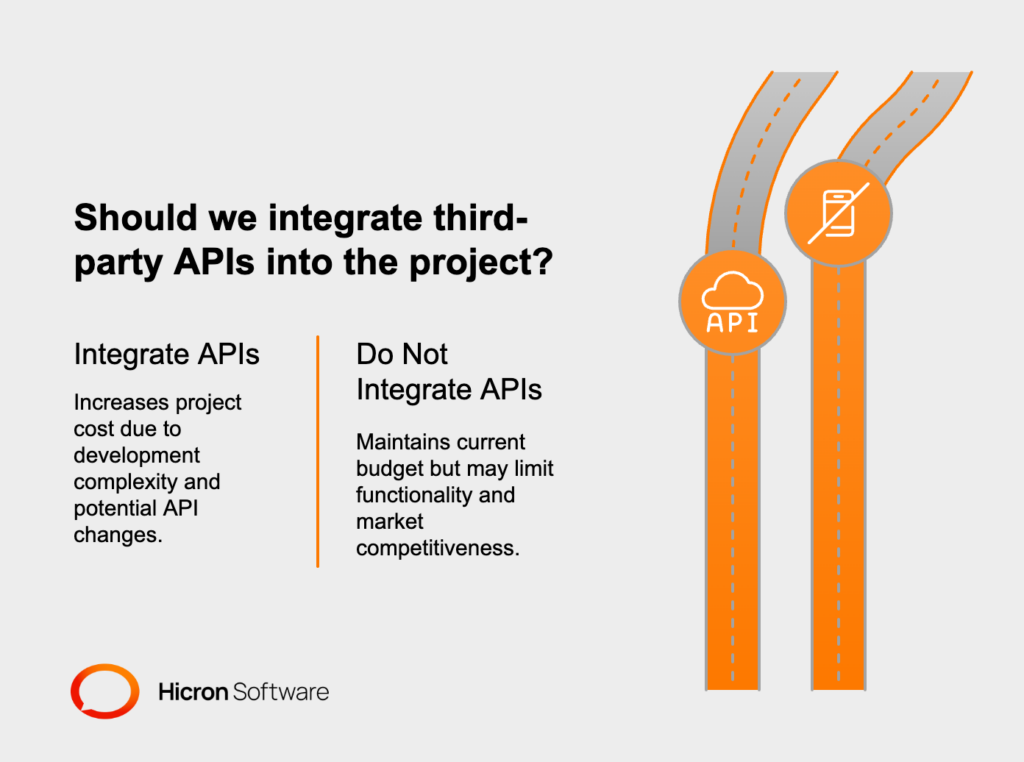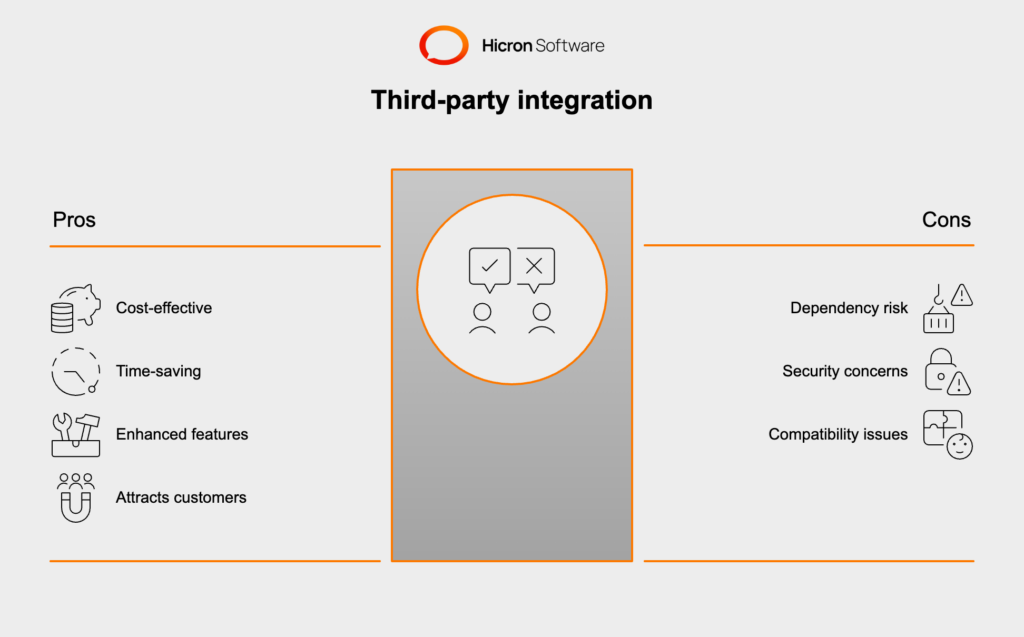Methods, types, pros and cons of system integration
- August 31
- 10 min

If you’re like most entrepreneurs, you’re always looking for ways to boost your company’s productivity. One way to do this is by integrating third-party systems with your workflow. This can help improve communication and collaboration between team members. In this article, we’ll explore some of the best ways to integrate third-party systems into your company’s operations. We’ll also share some tips on how to make the process as smooth as possible. So, if you’re ready to take your business to the next level, keep reading!
Third-party integrations are connections between two or more apps that rely on an external platform. The features of these platforms make them convenient for building large-scale integrations and often provide unique benefits such as scalability not found in natively built ones. Third-party integrations are a great way to build new solutions in less time. They give you the opportunity for third-party APIs that will automate certain processes and make them easier, ultimately saving developers valuable development hours.
Integrations like this are a great way to expand your product’s capabilities. Third-party API providers offer a list of additional features, which can be combined with the built-in ones for even more functionality. Think about how easier it could be if someone had made all these tools available before you started developing. In this article, we go over what third parties bring and provide some excellent tips when choosing external systems that will suit any needs – whether big or small.

Integrating third-party software with your device can be done in many ways, such as through APIs or app stores. Device integration means adding external data to existing projects using different devices and application program interfaces (APIs).
Third-party software is a great way to get your new solution up and running in record time. You can take components that are already available, instead of writing all the code from scratch. It’s also good because it will connect any device with this particular program so you have easy access at hand no matter what kind or model may be necessary for each project, saving both – money spent on developing devices as well as operational expenses associated therewith when trying multiple types simultaneously.
The API (Application Programming Interface) is the interface between two pieces of software, which enables them to communicate using definitions and protocols. Interfaces are essential in maintaining the relationship between two applications. They allow for requests and responses that define how each application communicates with its counterpart, which can be a kind of agreement on service terms or contract-based trade.
For example, the weather app on your phone “talks” to a database of daily data via APIs and will show you what’s forecast for today. The importance here is not only understanding what kind interfaces provide but also why they’re so important when developing software.
APIs are the lifeblood of any modern application, giving developers access to all sorts of functionality. The word “application” can refer specifically to apps that have been built using this software intermediary that allows two applications to talk to each other – such as an app with a distinct function like social media platform- but it’s more often used when discussing how these functions will be utilized by other pieces in order make something work better together.
The API documentation is an invaluable resource for any developer who wants to use the platform. It contains detailed instructions on how requests should be formatted and responses returned, so you can rest easy knowing your data won’t get lost.

Third-party APIs and your project cost If you want to add third-party integrations, be aware that this will increase the final price of any app. The more features an integration has in common with other apps on market today means a higher development bill for coding them all up – so it’s important not only to think about what exactly needs to be done but also how much time we’re willing to spend crafting each individual module.
Hiring the right developer is essential. You have to make sure your app works seamlessly with third-party APIs. You’ll need someone who has the knowledge of all required integration points, and it’s important that they do their research before beginning the work on any new feature or update so you don’t end up in a situation where one thing breaks due to another party having changed its API without notifying anyone else involved – this would be very frustrating for both parties.
Implementing a complex API will require extra work, especially if you want it done right and on time. That’s why we’re predicting an increase in costs for those who take this step – but don’t worry, our experts say that most companies can still afford these improvements as long as they know what their needs are.

Software integration challenges don’t have to be a common experience during 3rd party QA testing. In fact, the right 3rd party integration testing procedures in place can alleviate any issues that often arise during the third-party application testing process. Follow these best practices in this API testing tutorial so that your third-party software testing practices prevent problems before they occur.
When testing third-party applications, it is important to test them in context and not just on your product. There is always the chance that issues with the app will be filed as product bugs. This can slow down your time-to-market drastically and affect how long it takes before you actually get started integrating them into production systems.
The best way to ensure that your QA team is always up-to-date with the latest knowledge of all domains is to create an in the depth library filled only with detailed resources. Training sessions can also be run regularly across every member of staff so they will always be up-to-date as the topic is changing constantly.
Integration is a vital part of your product, so it’s important to test before releasing new features or updates. When testing third-party application we sometimes run into issues where there is no connection to the backend of an app because there was no support offered by the platform or when third parties don’t give access rights on certain levels within software programs.
Check out your third-party application’s functionality before and after integrating with the system. This way, you can make sure there are no negative impacts on how things work in terms of workflow or features for this particular product.
Integration issues are a huge pain point for software companies, and they often arise after upgrading either your product or an external third-party application. Features start disappearing or breaking down with the update.
The best way to avoid issues after an upgrade is by fully testing it before release. This includes performance regression tests, security checks, and performance evaluations on your application with all new third-party integrations that may affect how you use them both online or offline.
Great software is often built in-house, but what if you want to do more? Imagine your favorite app or program without the crucial feature of enhancing its performance.
Instead of developing a new piece of software, consider integrating an existing third-party add into your system. This way you can take advantage and use this feature while avoiding any potentially costly development projects.
An integration like this is the addition of external data to your business app through an API. The goal with this type of programming style would be that one application can talk directly into another, rather than having multiple applications on hand at once which could slow down performance or cause compatibility issues when trying to transfer information back and between them.
The use of third-party software is becoming more popular in the coding world because it can add new features without taking up time or resources. For example, if you want to create an app that provides online services but has limited code space available on your own laptop then using APIs might just work out better than building everything from scratch.
Third-party software integrations offer a way to save time and money by incorporating features you don’t have the resources for. Third parties are essential in developing your own product because they can provide powerful tools that attract new customers as well.

Let’s see in a brief overview what are the main advantages of this type of integration:
Third-party integrations are a time-saver. You can spend less of your day writing software codes, which means that you have more opportunities for other development activities like marketing or training employees.
With increased development time, you can enhance your app’s unique features to meet user expectations. With the money you saved, you start with a basic but useful project and make it bigger than ever before.
By integrating third-party software into your app, you are able to offer customers a world-class experience. Integrating these solutions with the current features of the product allow you not only to provide more value but also increases its credibility in front of customers’ eyes.
Third-party integrations are a great way to make your application more appealing. They improve the user experience as well since it will be easier for users with these features integrated into their accounts or devices.
Check our case study about integrating machines on the production line with ERP systems.
Integrating with third-party systems will help you work more effectively. It’s important to keep track of your data across different applications, but doing so can be difficult without integration happening on both ends.
Imagine how quickly you could approve invoices if they were all automatically matched with their corresponding purchases. This is where rule-based systems come in handy. With one simple search, your business will be able to see which orders require payment and when those payments need to be submitted. For example, instead of manually searching for a product owner in the database or file cabinet, you can create an automated workflow that will integrate with your accounting software and identify any discrepancies. Isn’t it great?
You can learn more about how it works, by reading our case study about ERP systems integrated with POS.
Integrating your business with other software is not always easy and can take some time. That’s why many businesses turn towards APIs, which provide an easier way of integrating into different products much faster, however, the main thing is that integration with a specific piece of technology can often solve your business problem. As we mentioned before, there are plenty of great options for the usage of this type of integration and there are many more! If you have any questions, you can contact us and we will discuss your project. You can read more about the pros and cons of system integration in our previous article.
Third-party integration connects two or more applications through an external platform, such as APIs, allowing them to work together seamlessly. This type of integration adds new features or enhances functionality without building everything from scratch, saving time and resources.
Third-party integration helps businesses boost productivity by streamlining workflows, automating processes, and improving communication between systems. It also reduces costs, enhances functionality, and allows companies to focus on their core operations instead of developing complex in-house solutions.
Using third-party APIs offers several benefits, including:
Faster production: Pre-built solutions save development time.
Cost reduction: Lower expenses by reusing existing components.
Improved features: Leverage powerful tools and advanced features from external systems.
Better user experience: Provide seamless, enhanced functionality to your customers.
Third-party integration can come with challenges, such as:
Compatibility issues: Ensuring systems work well together.
Higher costs: Integrating complex APIs can increase development expenses.
Dependency risks: Relying on external providers who may change or discontinue services.
Testing hurdles: Verifying proper communication between the systems can be time-consuming.
Follow these best practices for integration:
Understand the product: Gain detailed knowledge of the systems you’re integrating.
Test thoroughly: Ensure compatibility and address potential defects before launch.
Verify communication: Double-check interactions between your system and the third-party application.
Monitor updates: Regularly test integrations when software is updated to prevent issues.
Third-party integrations simplify processes and enhance the functionality of applications, making them more user-friendly. By combining the strengths of various systems, you can provide a seamless experience, such as faster workflows, real-time updates, and access to advanced features, ultimately increasing customer satisfaction.
When selecting a third-party system, consider:
Compatibility: Ensure it integrates smoothly with your existing systems.
Scalability: Look for solutions that can grow with your business.
Support: Choose providers with reliable customer support and clear documentation.
Cost: Balance affordability with the features and benefits offered.
Security: Verify that the system meets industry standards for data protection.
By keeping these factors in mind, you can choose the right system to meet your business needs.
To integrate a third-party system, follow these steps:
Identify a third-party tool or API that meets your needs.
Review the API documentation to understand its functionality and requirements.
Set up authentication or obtain API keys to access the third-party service.
Develop code or use integration platforms to establish communication between your system and the third-party API.
Test the integration thoroughly to ensure compatibility and functionality.
Monitor and update the integration periodically to maintain performance.
When using a third-party API:
Read and understand the API documentation thoroughly.
Authenticate securely using keys or tokens without exposing them.
Handle errors gracefully to ensure system reliability.
Test the API’s functionality in a sandbox or development environment.
Monitor API usage limits to avoid service disruptions.
Regularly update the integration to match API updates or changes.
An example of third-party system integration is connecting a Customer Relationship Management (CRM) tool like Salesforce to an email marketing platform such as Mailchimp. This integration enables customer data from Salesforce to sync with Mailchimp for targeted email marketing campaigns.
Third-party data integration combines external data sources with your internal systems through APIs or data connectors. For instance, linking weather data from a third-party API into an agriculture software platform helps provide actionable insights to farmers based on real-time weather conditions.
To create a third-party API:
Define the purpose and scope of the API.
Design endpoints and choose data formats like JSON or XML.
Implement back-end functionality to support the API using programming languages like Python or Java.
Provide secure authentication methods such as OAuth or API keys.
Document the API thoroughly with clear instructions and examples.
Test the API for performance, scalability, and ease of use.
Third-party techniques involve leveraging external systems, tools, or APIs to enhance your product or service. For example, using a third-party payment gateway like PayPal within your e-commerce app is a common technique to provide secure and fast transactions.
APIs (Application Programming Interfaces) enable systems to communicate by defining how data is exchanged. Third-party integrations use APIs to connect different systems. For example, integrating a third-party API like Google Maps into a mobile app provides location services seamlessly.
To integrate systems:
Identify integration goals and the systems to be connected.
Choose the right integration method, such as APIs, middleware, or ETL (Extract, Transform, Load) tools.
Ensure the systems share compatible data formats and protocols.
Develop or use pre-built integration solutions to connect them.
Test for functionality, performance, and data accuracy.
Monitor and refine the integration for consistent performance.
Examples of third-party components include:
Payment gateways like Stripe or PayPal.
Social media widgets like Facebook Login or Twitter Feed.
Mapping services like Google Maps or OpenStreetMap.
Cloud storage solutions like Dropbox or Google Drive.
Messaging services like Twilio for SMS or WhatsApp.
These components are integrated into applications to expand their functionality efficiently.
